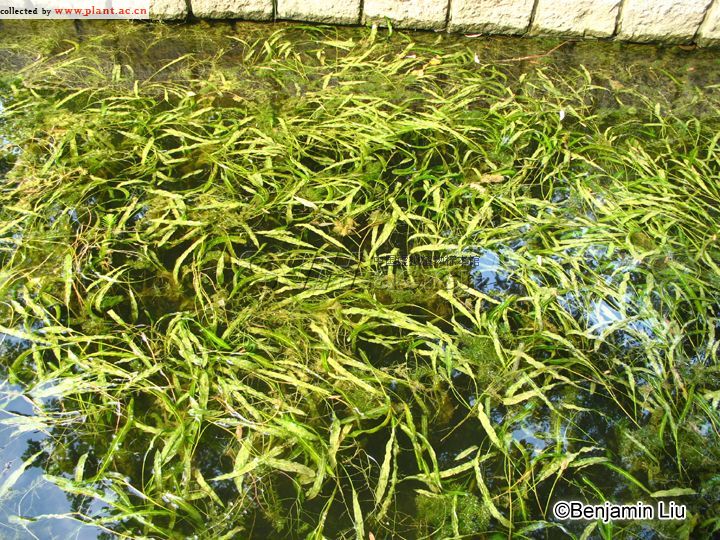竹叶眼子菜Potamogeton malaianus Miq.
竹叶眼子菜Potamogeton malaianus Miq.
11. 竹叶眼子菜(东北植物检索表)箬叶藻(植物学大辞典),马来眼子菜 图版22
Potamogeton malaianus Miq., 111. Fl. Arch. Ind. 46. 1871; A. Benn. in Journ. Linn. Soc. Bot. 36: 194. 1903; Asch. et Graebn. in Engl. Pflanzenr. 31 (IV 11): 83. 1907; Hagstrom in Kungl. Svenska Vetenskapsakad. Handl. 55 (5): 248. f. 115A-E. 1916; Miyabe et Kudo in Journ. Fac. Agr. 26 (2): 89. 1931; Kuzm. et Skv. in Philip. Journ. Sci. 74 (4): 404. pl. 10. f. 1-3, 5-9, pl. 11. f. 1-22. 1941; 佐藤润平, 满洲水草图谱150. 图75: 1942; 华东水生维管束植物11.图10. 1952; Masam., List. Vasc. Pl. Taiwan 131. 1954; 东北植物检索表450.图版165.图1. 1959; 北京地区植物志 (单子叶植物) 12. 图11. 1975;中国高等植物图鉴5: 9. 图6847-1976; 江苏植物志 上册 127.图200. 1977; 台湾植物志5: 28. 1978.——P. gaudichaudii Cham. et Schl. in Linnaea 2: 177, 199. 1827; 广州植物志652. 1956. ——P. mucronatus Presl. in Abh. Bohm. Ges. Wiss. 6: 245 (Epimel. Bot.). 1851; Henry in Trans. Asiat. Soc. Japan 24. Suppl. 101. 1896. ——P. japonicus Franch. et Sav., Enum. Pl. Jap. 2: 15. 1879; Sasaki, List. Pl. Form. 55. 1928.
多年生沉水草本。根茎发达,白色,节处生有须根。茎圆柱形,直径约2毫米,不分枝或具少数分枝,节间长可达10余厘米。叶条形或条状披针形,具长柄,稀短于2厘米;叶片长5-19厘米,宽1-2.5厘米,先端钝圆而具小凸尖,基部钝圆或楔形,边缘浅波状,有细微的锯齿;中脉显著,自基部至中部发出6至多条与之平行、并在顶端连接的次级叶脉,三级叶脉清晰可见;托叶大而明显,近膜质,无色或淡绿色,与叶片离生,鞘状抱茎,长2.5-5厘米。穗状花序顶生,具花多轮,密集或稍密集;花序梗膨大,稍粗于茎,长4-7厘米;花小,被片4,绿色;雌蕊4枚,离生。果实倒卵形,长约3毫米,两侧稍扁,背部明显3脊,中脊狭翅状,侧脊锐。花果期6-10月。2n=52。
解剖特征:茎具皮下层,皮层中具有散生的机械束;维管柱为“多束型”,具多条木质管道;内皮层由。型和U型细胞所组成(O-U型);叶柄及花序柄中均具有散生的机械束。
产我国南北各省区。生于灌渠、池塘、河流等静、流水体,水体多呈微酸性。原苏联朝鲜、日本、东南亚各国及印度也有分布。
《Flora of China》 Vol. 23 (2010)
Potamogeton wrightii Morong Bull. Torrey Bot. Club. 13: 158. 1886.
竹叶眼子菜 zhu ye yan zi cai
Potamogeton intortusifolius J. B. He, L. Y. Zhou & H. Q. Wang; P. japonicus Franchet & Savatier; P. mucronatus C. Presl (1851), not Schrader ex Sonder (1850).
Plants perennial, submerged. Rhizome terete, slender. Stems simple or rarely sparsely branched, internodes elongated, terete, ca. 2 mm in diam. Stipules axillary, convolute, large and conspicuous, 2.5-5 cm, membranous, free from leaf base. Submerged leaves petiolate; petiole 1.6-14 cm; blade narrowly oblong to oblong-lanceolate, 8-20(-31) × (0.7-)1.4-2(-2.7) cm, 9-13-veined, with a conspicuous midvein, base rounded or cuneate, margin undulate and minutely denticulate, apex mucronate. Floating leaves usually absent, sometimes present, bright green, often with reddish tinge, oblong to elliptic, 5.2-12.5 × 1.2-2.5 cm, 11-25-veined, base cuneate, apex mucronate. Spikes densely flowered, with many whorls of opposite flowers; peduncles 4-7 cm, thickened upward. Carpels 4. Fruit obovoid, 2-3.3 mm, abaxial keels 3, distinct, with a narrowly winglike midvein; beak short. Fl. and fr. Jun-Oct. 2n = 52.
Lakes, rivers, channels, ponds. Anhui, Fujian, Hebei, Heilongjiang, Henan, Hubei, Hunan, Jilin, Liaoning, Nei Mongol, Ningxia, Qinghai, Shaanxi, Shandong, Shanxi, Sichuan, Taiwan, Xinjiang, Yunnan, Zhejiang [India, Indonesia, Japan, Kazakhstan, Korea, Laos, Malaysia, Myanmar, New Guinea, Pakistan, Philippines, Russia, Thailand, Vietnam; Pacific islands].
The species here called Potamogeton wrightii was generally treated under the name "P. malaianus," but the type specimen of P. malaianus Miquel is actually P. nodosus.The species here called Potamogeton wrightii was generally treated under the name "P. malaianus," but the type specimen of P. malaianus Miquel is actually P. nodosus.
别名:马来眼子菜、箬叶藻
科名:眼子菜科 Potamogetonaceae
属名:眼子菜属 Potamogeton

11. 竹叶眼子菜(东北植物检索表)箬叶藻(植物学大辞典),马来眼子菜 图版22
Potamogeton malaianus Miq., 111. Fl. Arch. Ind. 46. 1871; A. Benn. in Journ. Linn. Soc. Bot. 36: 194. 1903; Asch. et Graebn. in Engl. Pflanzenr. 31 (IV 11): 83. 1907; Hagstrom in Kungl. Svenska Vetenskapsakad. Handl. 55 (5): 248. f. 115A-E. 1916; Miyabe et Kudo in Journ. Fac. Agr. 26 (2): 89. 1931; Kuzm. et Skv. in Philip. Journ. Sci. 74 (4): 404. pl. 10. f. 1-3, 5-9, pl. 11. f. 1-22. 1941; 佐藤润平, 满洲水草图谱150. 图75: 1942; 华东水生维管束植物11.图10. 1952; Masam., List. Vasc. Pl. Taiwan 131. 1954; 东北植物检索表450.图版165.图1. 1959; 北京地区植物志 (单子叶植物) 12. 图11. 1975;中国高等植物图鉴5: 9. 图6847-1976; 江苏植物志 上册 127.图200. 1977; 台湾植物志5: 28. 1978.——P. gaudichaudii Cham. et Schl. in Linnaea 2: 177, 199. 1827; 广州植物志652. 1956. ——P. mucronatus Presl. in Abh. Bohm. Ges. Wiss. 6: 245 (Epimel. Bot.). 1851; Henry in Trans. Asiat. Soc. Japan 24. Suppl. 101. 1896. ——P. japonicus Franch. et Sav., Enum. Pl. Jap. 2: 15. 1879; Sasaki, List. Pl. Form. 55. 1928.
多年生沉水草本。根茎发达,白色,节处生有须根。茎圆柱形,直径约2毫米,不分枝或具少数分枝,节间长可达10余厘米。叶条形或条状披针形,具长柄,稀短于2厘米;叶片长5-19厘米,宽1-2.5厘米,先端钝圆而具小凸尖,基部钝圆或楔形,边缘浅波状,有细微的锯齿;中脉显著,自基部至中部发出6至多条与之平行、并在顶端连接的次级叶脉,三级叶脉清晰可见;托叶大而明显,近膜质,无色或淡绿色,与叶片离生,鞘状抱茎,长2.5-5厘米。穗状花序顶生,具花多轮,密集或稍密集;花序梗膨大,稍粗于茎,长4-7厘米;花小,被片4,绿色;雌蕊4枚,离生。果实倒卵形,长约3毫米,两侧稍扁,背部明显3脊,中脊狭翅状,侧脊锐。花果期6-10月。2n=52。
解剖特征:茎具皮下层,皮层中具有散生的机械束;维管柱为“多束型”,具多条木质管道;内皮层由。型和U型细胞所组成(O-U型);叶柄及花序柄中均具有散生的机械束。
产我国南北各省区。生于灌渠、池塘、河流等静、流水体,水体多呈微酸性。原苏联朝鲜、日本、东南亚各国及印度也有分布。
《Flora of China》 Vol. 23 (2010)
Potamogeton wrightii Morong Bull. Torrey Bot. Club. 13: 158. 1886.
竹叶眼子菜 zhu ye yan zi cai
Potamogeton intortusifolius J. B. He, L. Y. Zhou & H. Q. Wang; P. japonicus Franchet & Savatier; P. mucronatus C. Presl (1851), not Schrader ex Sonder (1850).
Plants perennial, submerged. Rhizome terete, slender. Stems simple or rarely sparsely branched, internodes elongated, terete, ca. 2 mm in diam. Stipules axillary, convolute, large and conspicuous, 2.5-5 cm, membranous, free from leaf base. Submerged leaves petiolate; petiole 1.6-14 cm; blade narrowly oblong to oblong-lanceolate, 8-20(-31) × (0.7-)1.4-2(-2.7) cm, 9-13-veined, with a conspicuous midvein, base rounded or cuneate, margin undulate and minutely denticulate, apex mucronate. Floating leaves usually absent, sometimes present, bright green, often with reddish tinge, oblong to elliptic, 5.2-12.5 × 1.2-2.5 cm, 11-25-veined, base cuneate, apex mucronate. Spikes densely flowered, with many whorls of opposite flowers; peduncles 4-7 cm, thickened upward. Carpels 4. Fruit obovoid, 2-3.3 mm, abaxial keels 3, distinct, with a narrowly winglike midvein; beak short. Fl. and fr. Jun-Oct. 2n = 52.
Lakes, rivers, channels, ponds. Anhui, Fujian, Hebei, Heilongjiang, Henan, Hubei, Hunan, Jilin, Liaoning, Nei Mongol, Ningxia, Qinghai, Shaanxi, Shandong, Shanxi, Sichuan, Taiwan, Xinjiang, Yunnan, Zhejiang [India, Indonesia, Japan, Kazakhstan, Korea, Laos, Malaysia, Myanmar, New Guinea, Pakistan, Philippines, Russia, Thailand, Vietnam; Pacific islands].
The species here called Potamogeton wrightii was generally treated under the name "P. malaianus," but the type specimen of P. malaianus Miquel is actually P. nodosus.The species here called Potamogeton wrightii was generally treated under the name "P. malaianus," but the type specimen of P. malaianus Miquel is actually P. nodosus.

